проект психология.pptx
- Количество слайдов: 31
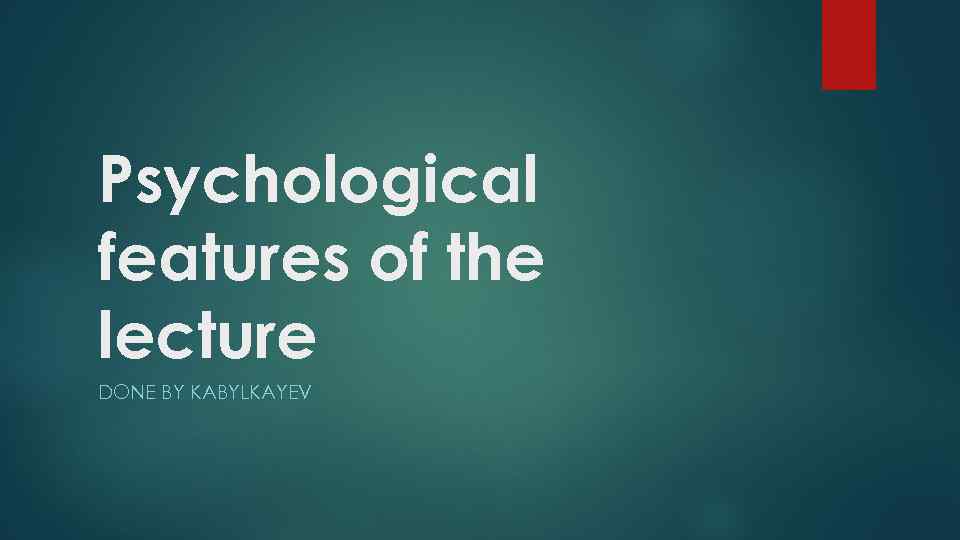
Psychological features of the lecture DONE BY KABYLKAYEV
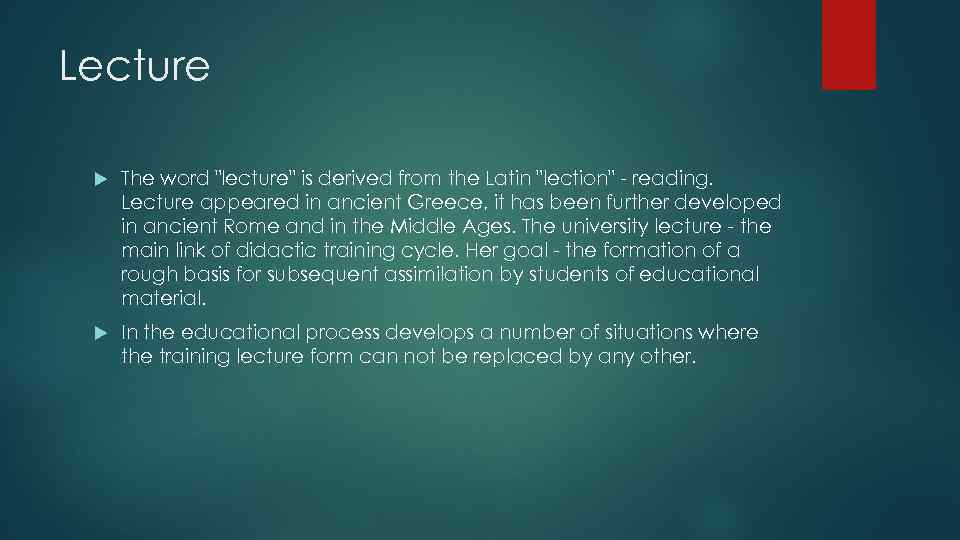
Lecture The word "lecture" is derived from the Latin "lection" - reading. Lecture appeared in ancient Greece, it has been further developed in ancient Rome and in the Middle Ages. The university lecture - the main link of didactic training cycle. Her goal - the formation of a rough basis for subsequent assimilation by students of educational material. In the educational process develops a number of situations where the training lecture form can not be replaced by any other.
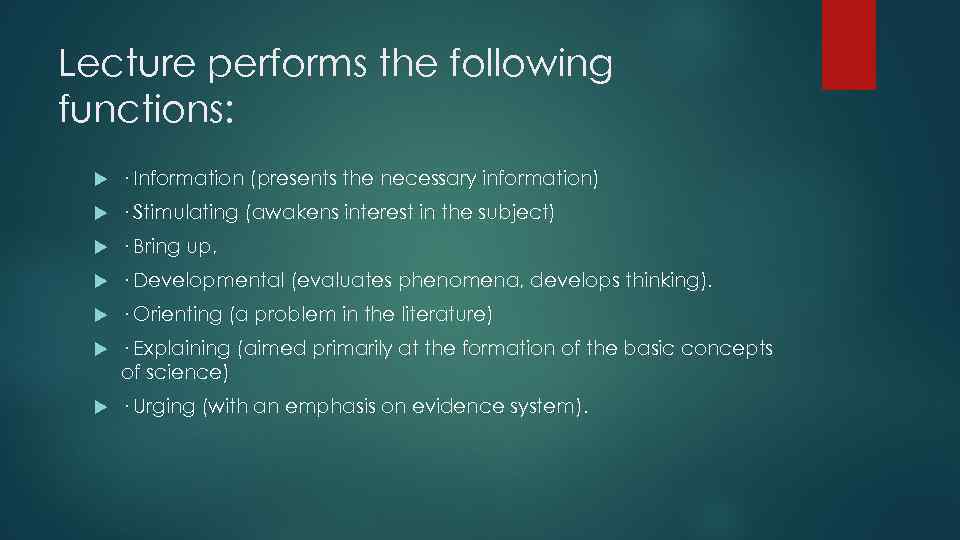
Lecture performs the following functions: · Information (presents the necessary information) · Stimulating (awakens interest in the subject) · Bring up, · Developmental (evaluates phenomena, develops thinking). · Orienting (a problem in the literature) · Explaining (aimed primarily at the formation of the basic concepts of science) · Urging (with an emphasis on evidence system).
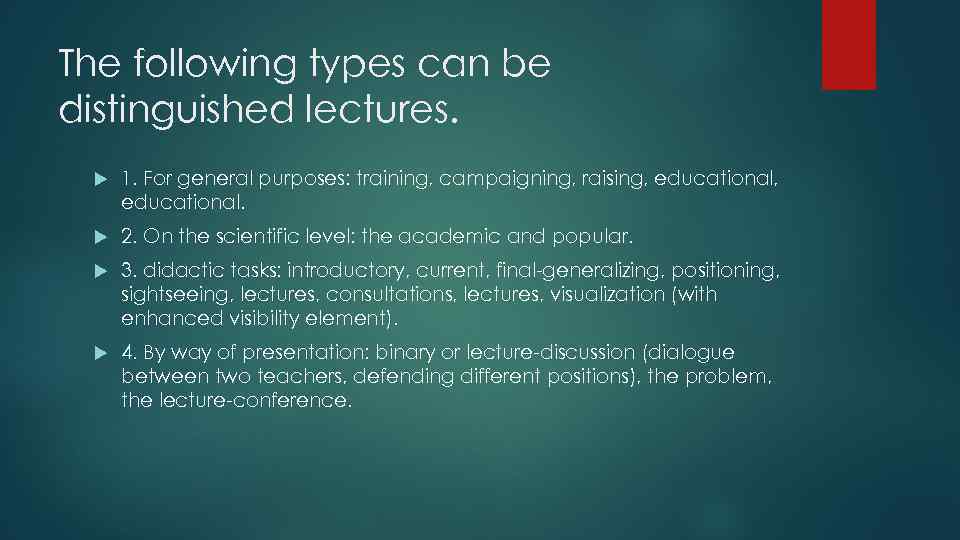
The following types can be distinguished lectures. 1. For general purposes: training, campaigning, raising, educational. 2. On the scientific level: the academic and popular. 3. didactic tasks: introductory, current, final-generalizing, positioning, sightseeing, lectures, consultations, lectures, visualization (with enhanced visibility element). 4. By way of presentation: binary or lecture-discussion (dialogue between two teachers, defending different positions), the problem, the lecture-conference.
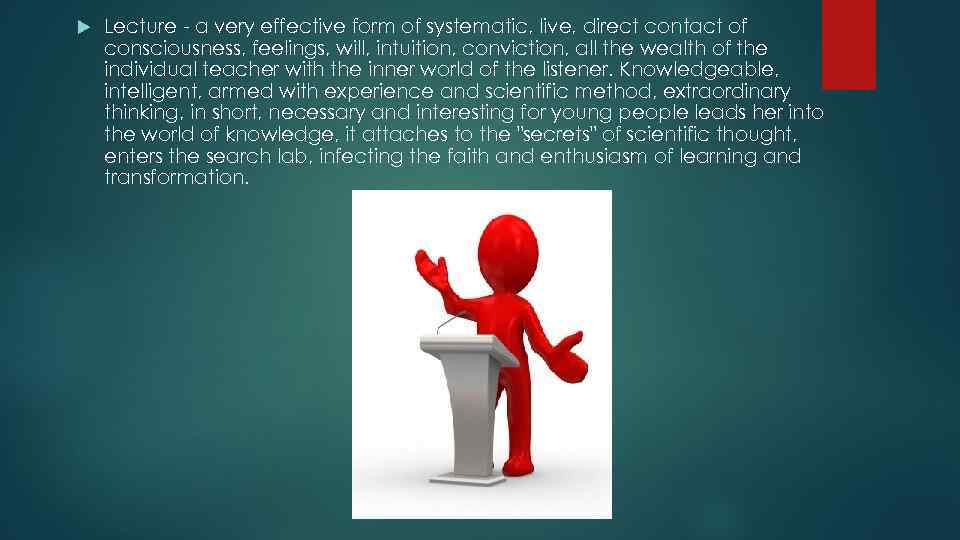
Lecture - a very effective form of systematic, live, direct contact of consciousness, feelings, will, intuition, conviction, all the wealth of the individual teacher with the inner world of the listener. Knowledgeable, intelligent, armed with experience and scientific method, extraordinary thinking, in short, necessary and interesting for young people leads her into the world of knowledge, it attaches to the "secrets" of scientific thought, enters the search lab, infecting the faith and enthusiasm of learning and transformation.
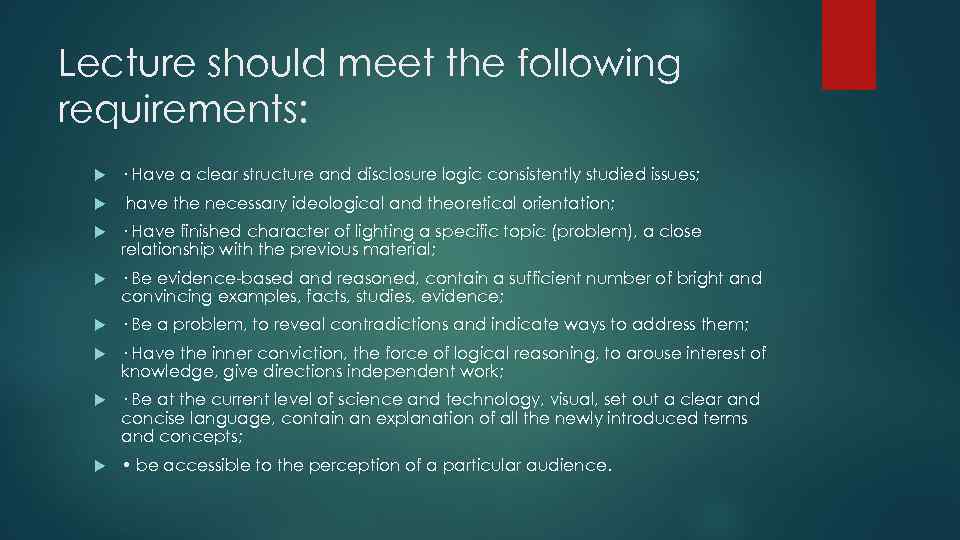
Lecture should meet the following requirements: · Have a clear structure and disclosure logic consistently studied issues; have the necessary ideological and theoretical orientation; · Have finished character of lighting a specific topic (problem), a close relationship with the previous material; · Be evidence-based and reasoned, contain a sufficient number of bright and convincing examples, facts, studies, evidence; · Be a problem, to reveal contradictions and indicate ways to address them; · Have the inner conviction, the force of logical reasoning, to arouse interest of knowledge, give directions independent work; · Be at the current level of science and technology, visual, set out a clear and concise language, contain an explanation of all the newly introduced terms and concepts; • be accessible to the perception of a particular audience.
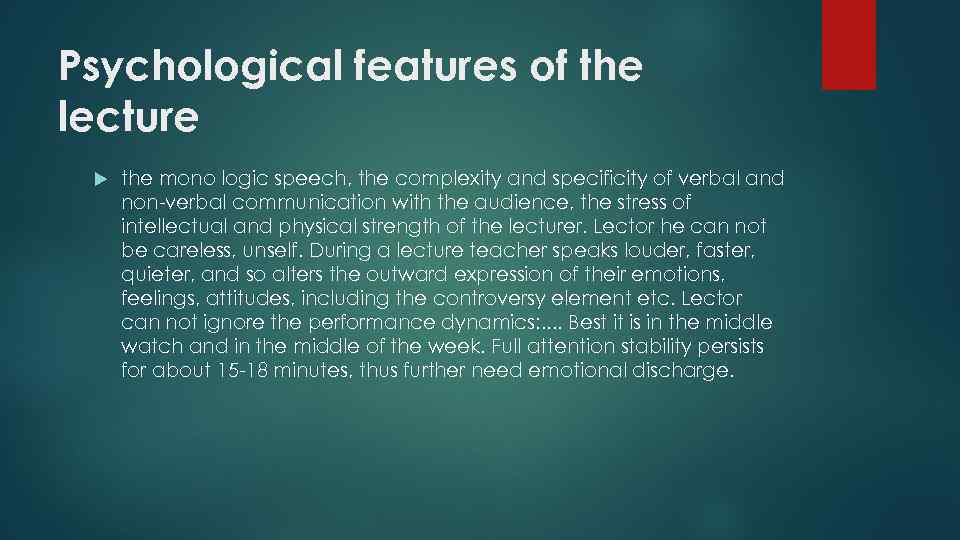
Psychological features of the lecture the mono logic speech, the complexity and specificity of verbal and non-verbal communication with the audience, the stress of intellectual and physical strength of the lecturer. Lector he can not be careless, unself. During a lecture teacher speaks louder, faster, quieter, and so alters the outward expression of their emotions, feelings, attitudes, including the controversy element etc. Lector can not ignore the performance dynamics: . . Best it is in the middle watch and in the middle of the week. Full attention stability persists for about 15 -18 minutes, thus further need emotional discharge.
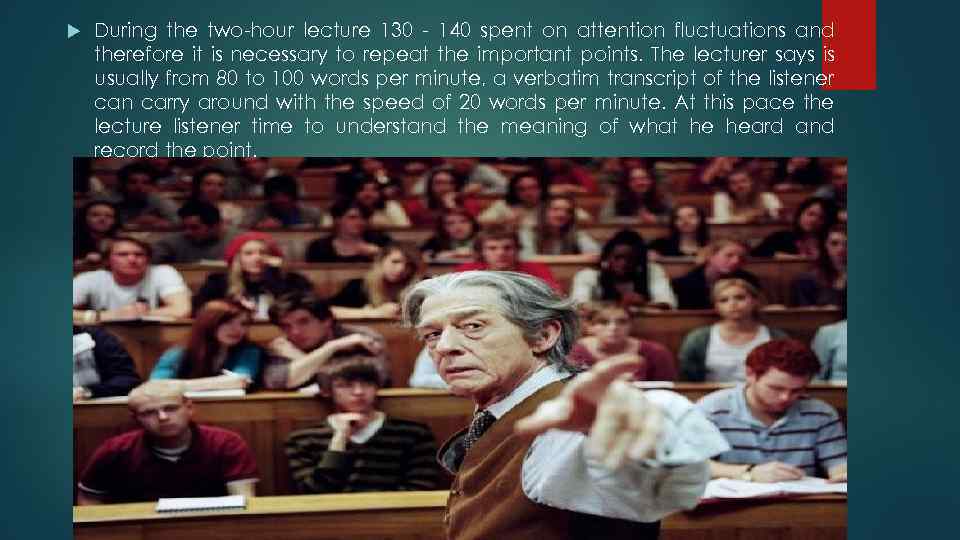
During the two-hour lecture 130 - 140 spent on attention fluctuations and therefore it is necessary to repeat the important points. The lecturer says is usually from 80 to 100 words per minute, a verbatim transcript of the listener can carry around with the speed of 20 words per minute. At this pace the lecture listener time to understand the meaning of what he heard and record the point.
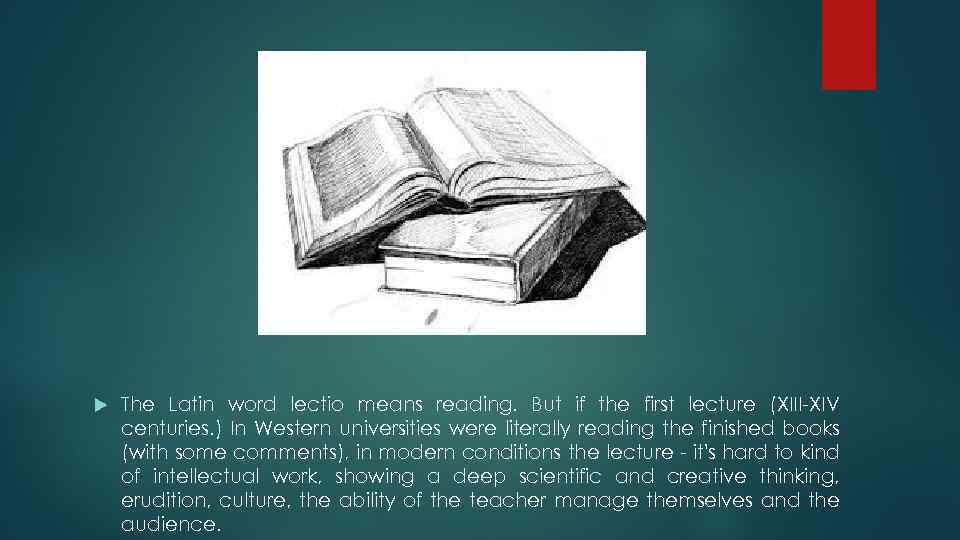
The Latin word lectio means reading. But if the first lecture (XIII-XIV centuries. ) In Western universities were literally reading the finished books (with some comments), in modern conditions the lecture - it's hard to kind of intellectual work, showing a deep scientific and creative thinking, erudition, culture, the ability of the teacher manage themselves and the audience.
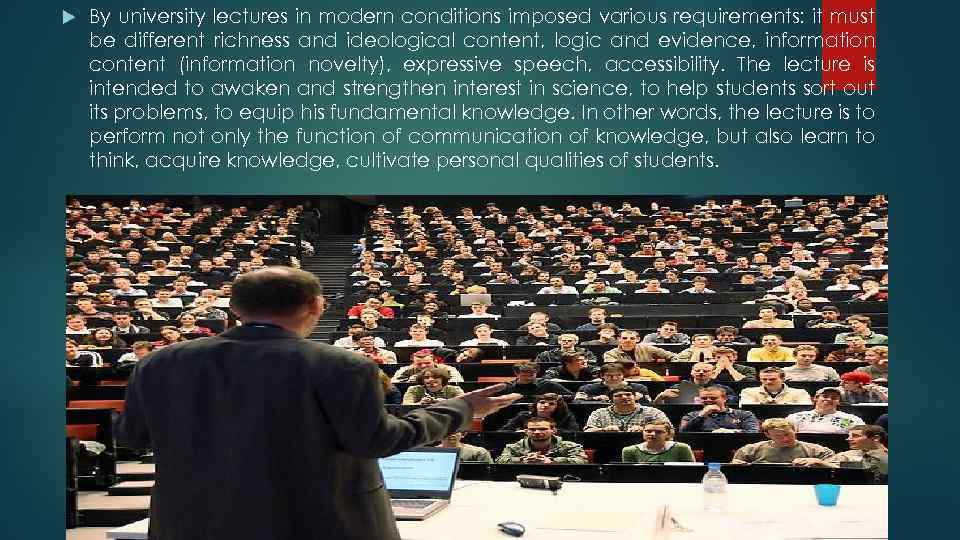
By university lectures in modern conditions imposed various requirements: it must be different richness and ideological content, logic and evidence, information content (information novelty), expressive speech, accessibility. The lecture is intended to awaken and strengthen interest in science, to help students sort out its problems, to equip his fundamental knowledge. In other words, the lecture is to perform not only the function of communication of knowledge, but also learn to think, acquire knowledge, cultivate personal qualities of students.
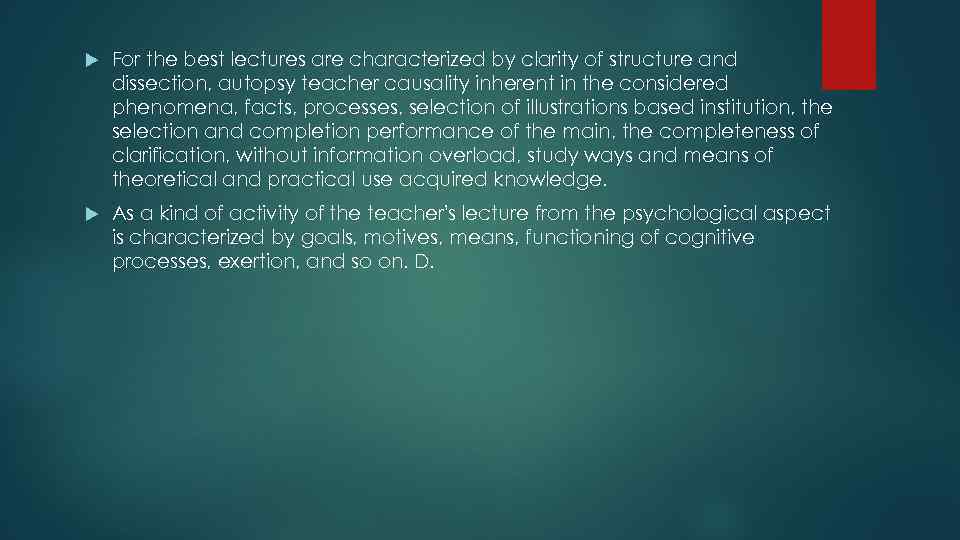
For the best lectures are characterized by clarity of structure and dissection, autopsy teacher causality inherent in the considered phenomena, facts, processes, selection of illustrations based institution, the selection and completion performance of the main, the completeness of clarification, without information overload, study ways and means of theoretical and practical use acquired knowledge. As a kind of activity of the teacher's lecture from the psychological aspect is characterized by goals, motives, means, functioning of cognitive processes, exertion, and so on. D.
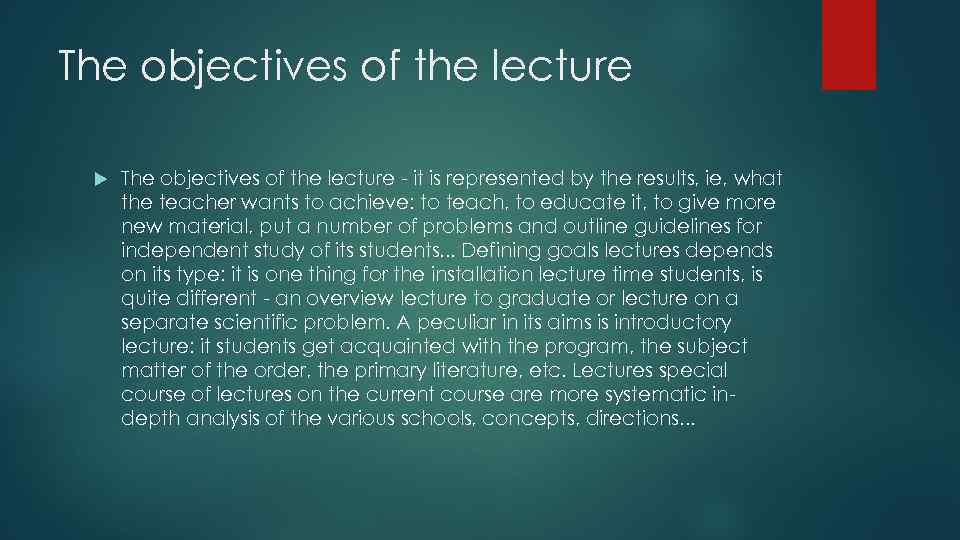
The objectives of the lecture - it is represented by the results, ie, what the teacher wants to achieve: to teach, to educate it, to give more new material, put a number of problems and outline guidelines for independent study of its students. . . Defining goals lectures depends on its type: it is one thing for the installation lecture time students, is quite different - an overview lecture to graduate or lecture on a separate scientific problem. A peculiar in its aims is introductory lecture: it students get acquainted with the program, the subject matter of the order, the primary literature, etc. Lectures special course of lectures on the current course are more systematic indepth analysis of the various schools, concepts, directions. . .
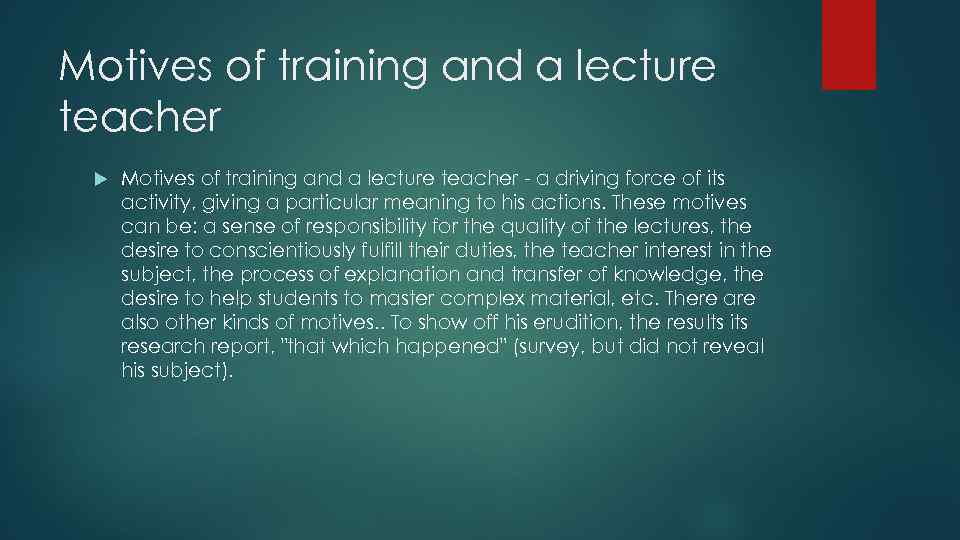
Motives of training and a lecture teacher - a driving force of its activity, giving a particular meaning to his actions. These motives can be: a sense of responsibility for the quality of the lectures, the desire to conscientiously fulfill their duties, the teacher interest in the subject, the process of explanation and transfer of knowledge, the desire to help students to master complex material, etc. There also other kinds of motives. . To show off his erudition, the results its research report, "that which happened" (survey, but did not reveal his subject).
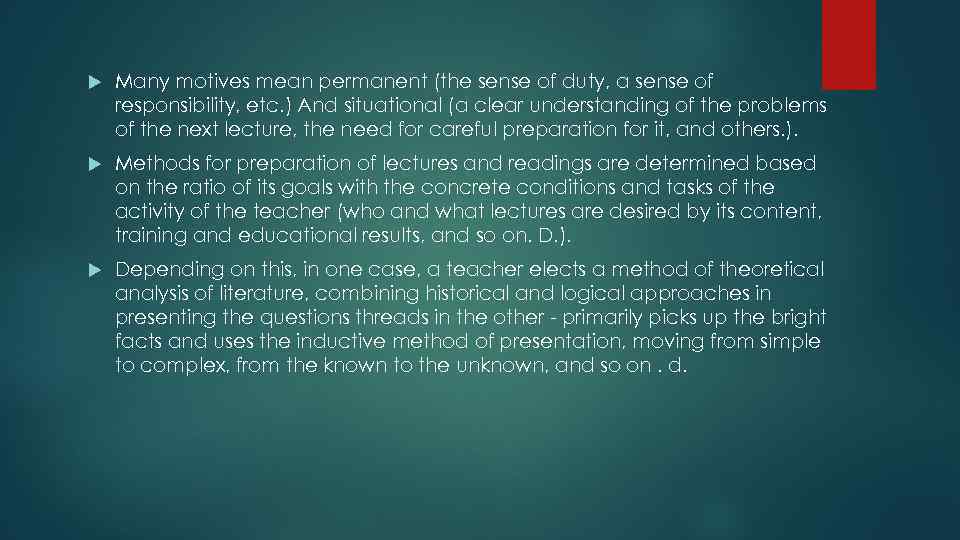
Many motives mean permanent (the sense of duty, a sense of responsibility, etc. ) And situational (a clear understanding of the problems of the next lecture, the need for careful preparation for it, and others. ). Methods for preparation of lectures and readings are determined based on the ratio of its goals with the concrete conditions and tasks of the activity of the teacher (who and what lectures are desired by its content, training and educational results, and so on. D. ). Depending on this, in one case, a teacher elects a method of theoretical analysis of literature, combining historical and logical approaches in presenting the questions threads in the other - primarily picks up the bright facts and uses the inductive method of presentation, moving from simple to complex, from the known to the unknown, and so on. d.
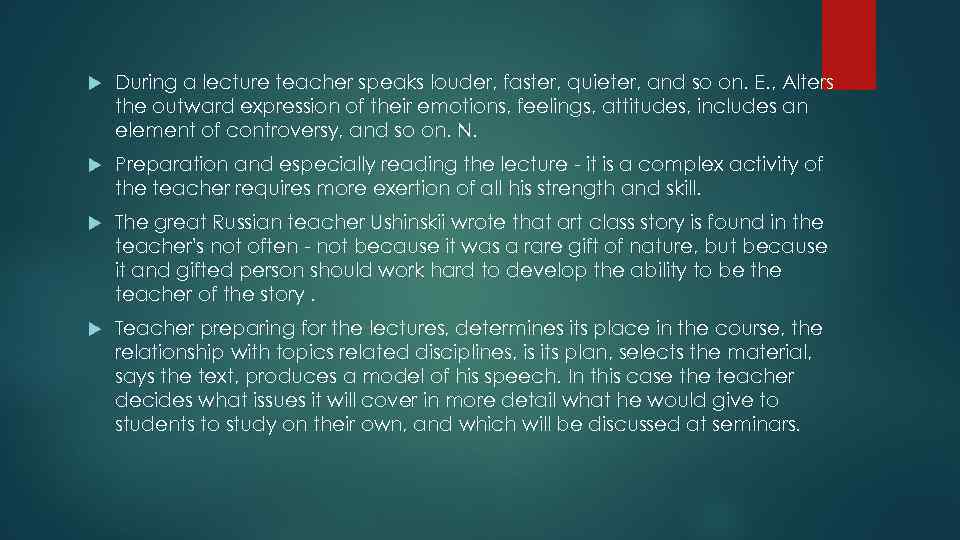
During a lecture teacher speaks louder, faster, quieter, and so on. E. , Alters the outward expression of their emotions, feelings, attitudes, includes an element of controversy, and so on. N. Preparation and especially reading the lecture - it is a complex activity of the teacher requires more exertion of all his strength and skill. The great Russian teacher Ushinskii wrote that art class story is found in the teacher's not often - not because it was a rare gift of nature, but because it and gifted person should work hard to develop the ability to be the teacher of the story. Teacher preparing for the lectures, determines its place in the course, the relationship with topics related disciplines, is its plan, selects the material, says the text, produces a model of his speech. In this case the teacher decides what issues it will cover in more detail what he would give to students to study on their own, and which will be discussed at seminars.
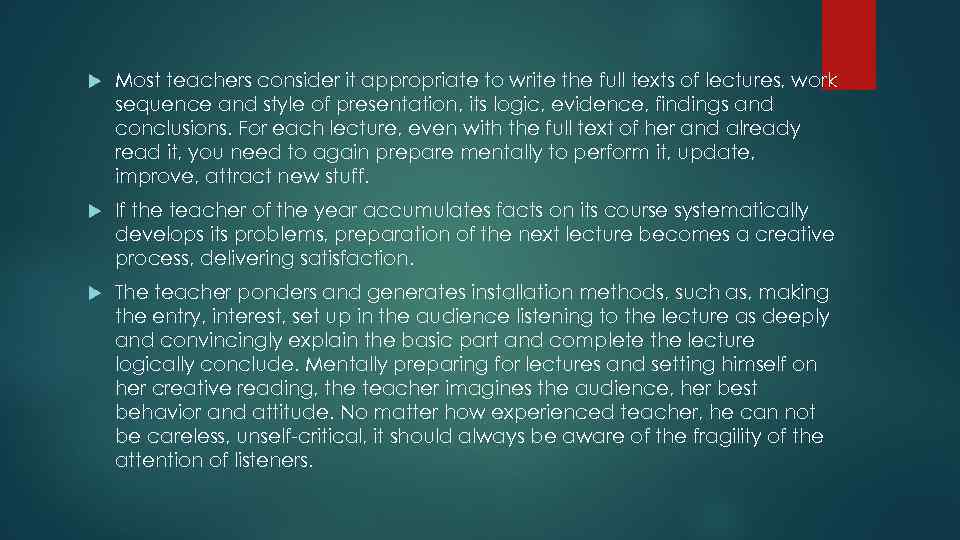
Most teachers consider it appropriate to write the full texts of lectures, work sequence and style of presentation, its logic, evidence, findings and conclusions. For each lecture, even with the full text of her and already read it, you need to again prepare mentally to perform it, update, improve, attract new stuff. If the teacher of the year accumulates facts on its course systematically develops its problems, preparation of the next lecture becomes a creative process, delivering satisfaction. The teacher ponders and generates installation methods, such as, making the entry, interest, set up in the audience listening to the lecture as deeply and convincingly explain the basic part and complete the lecture logically conclude. Mentally preparing for lectures and setting himself on her creative reading, the teacher imagines the audience, her best behavior and attitude. No matter how experienced teacher, he can not be careless, unself-critical, it should always be aware of the fragility of the attention of listeners.
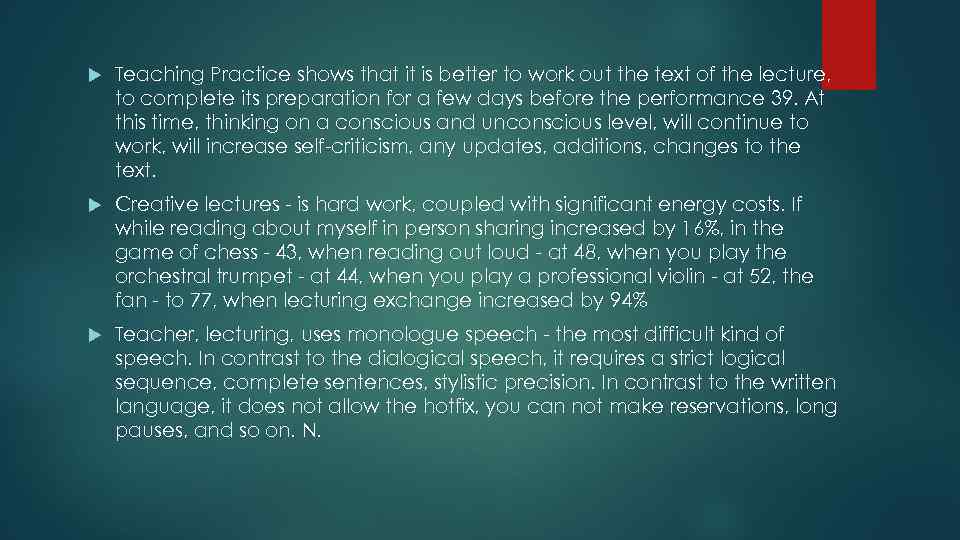
Teaching Practice shows that it is better to work out the text of the lecture, to complete its preparation for a few days before the performance 39. At this time, thinking on a conscious and unconscious level, will continue to work, will increase self-criticism, any updates, additions, changes to the text. Creative lectures - is hard work, coupled with significant energy costs. If while reading about myself in person sharing increased by 16%, in the game of chess - 43, when reading out loud - at 48, when you play the orchestral trumpet - at 44, when you play a professional violin - at 52, the fan - to 77, when lecturing exchange increased by 94% Teacher, lecturing, uses monologue speech - the most difficult kind of speech. In contrast to the dialogical speech, it requires a strict logical sequence, complete sentences, stylistic precision. In contrast to the written language, it does not allow the hotfix, you can not make reservations, long pauses, and so on. N.
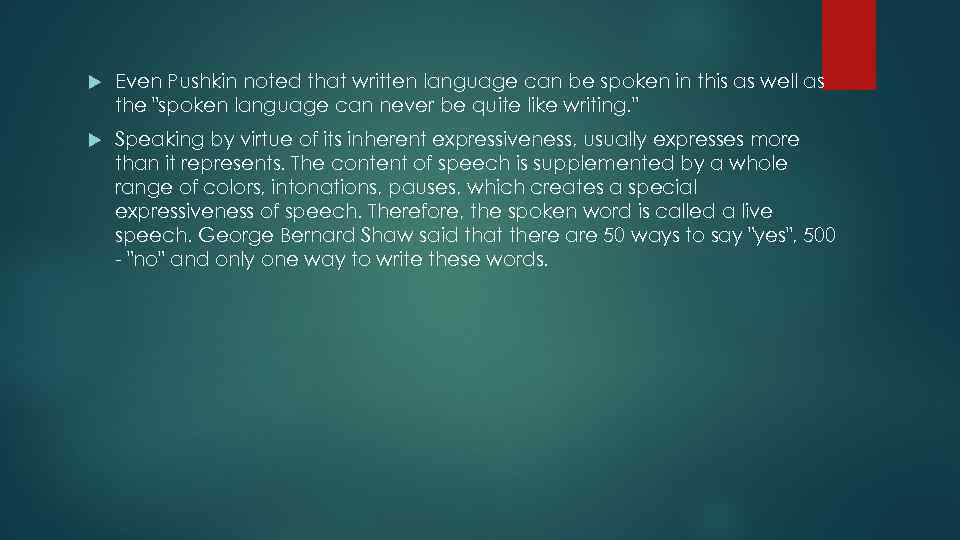
Even Pushkin noted that written language can be spoken in this as well as the "spoken language can never be quite like writing. " Speaking by virtue of its inherent expressiveness, usually expresses more than it represents. The content of speech is supplemented by a whole range of colors, intonations, pauses, which creates a special expressiveness of speech. Therefore, the spoken word is called a live speech. George Bernard Shaw said that there are 50 ways to say "yes", 500 - "no" and only one way to write these words.
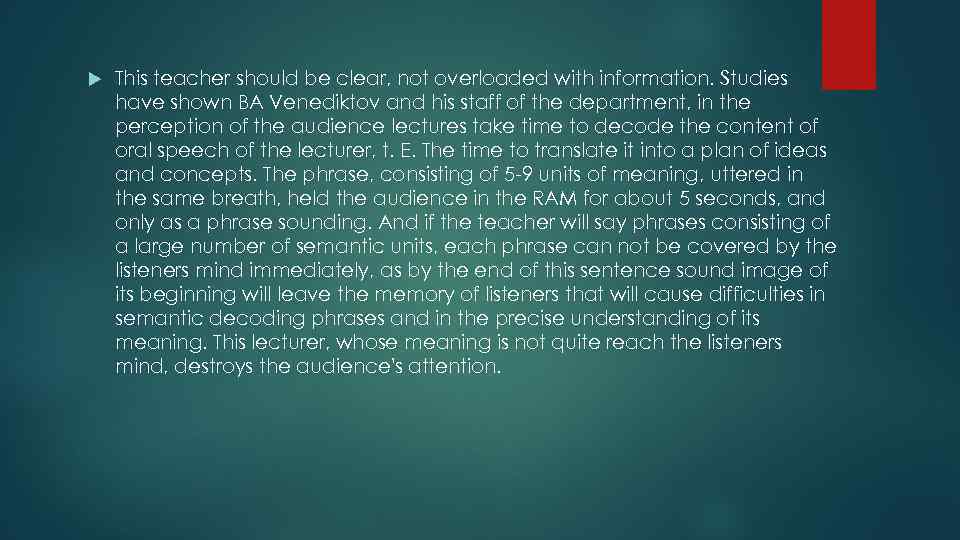
This teacher should be clear, not overloaded with information. Studies have shown BA Venediktov and his staff of the department, in the perception of the audience lectures take time to decode the content of oral speech of the lecturer, t. E. The time to translate it into a plan of ideas and concepts. The phrase, consisting of 5 -9 units of meaning, uttered in the same breath, held the audience in the RAM for about 5 seconds, and only as a phrase sounding. And if the teacher will say phrases consisting of a large number of semantic units, each phrase can not be covered by the listeners mind immediately, as by the end of this sentence sound image of its beginning will leave the memory of listeners that will cause difficulties in semantic decoding phrases and in the precise understanding of its meaning. This lecturer, whose meaning is not quite reach the listeners mind, destroys the audience's attention.
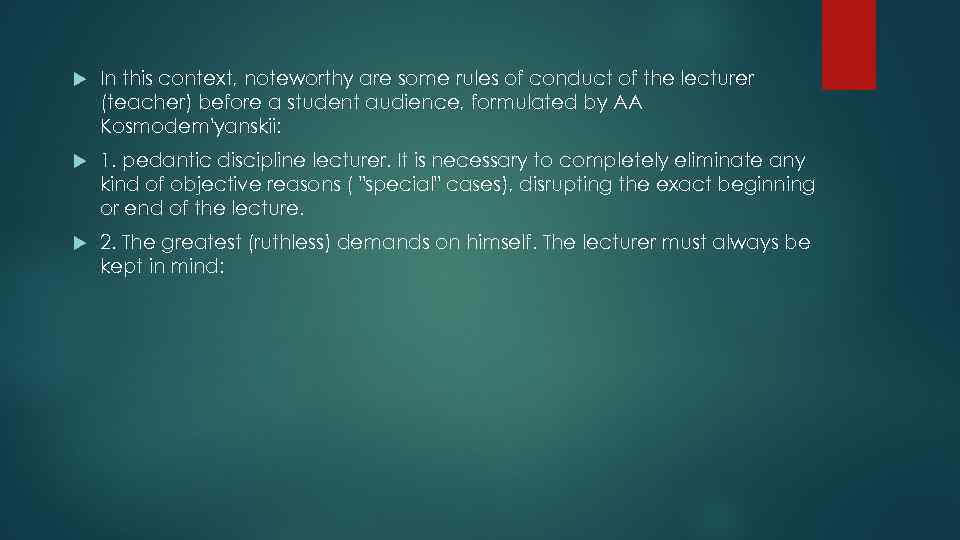
In this context, noteworthy are some rules of conduct of the lecturer (teacher) before a student audience, formulated by AA Kosmodem'yanskii: 1. pedantic discipline lecturer. It is necessary to completely eliminate any kind of objective reasons ( "special" cases), disrupting the exact beginning or end of the lecture. 2. The greatest (ruthless) demands on himself. The lecturer must always be kept in mind:
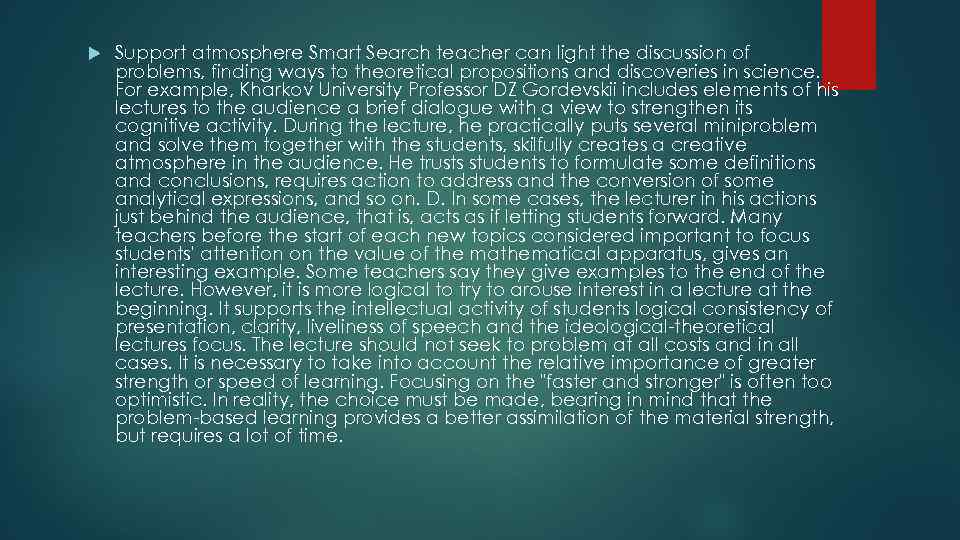
Support atmosphere Smart Search teacher can light the discussion of problems, finding ways to theoretical propositions and discoveries in science. For example, Kharkov University Professor DZ Gordevskii includes elements of his lectures to the audience a brief dialogue with a view to strengthen its cognitive activity. During the lecture, he practically puts several miniproblem and solve them together with the students, skilfully creates a creative atmosphere in the audience. He trusts students to formulate some definitions and conclusions, requires action to address and the conversion of some analytical expressions, and so on. D. In some cases, the lecturer in his actions just behind the audience, that is, acts as if letting students forward. Many teachers before the start of each new topics considered important to focus students' attention on the value of the mathematical apparatus, gives an interesting example. Some teachers say they give examples to the end of the lecture. However, it is more logical to try to arouse interest in a lecture at the beginning. It supports the intellectual activity of students logical consistency of presentation, clarity, liveliness of speech and the ideological-theoretical lectures focus. The lecture should not seek to problem at all costs and in all cases. It is necessary to take into account the relative importance of greater strength or speed of learning. Focusing on the "faster and stronger" is often too optimistic. In reality, the choice must be made, bearing in mind that the problem-based learning provides a better assimilation of the material strength, but requires a lot of time.
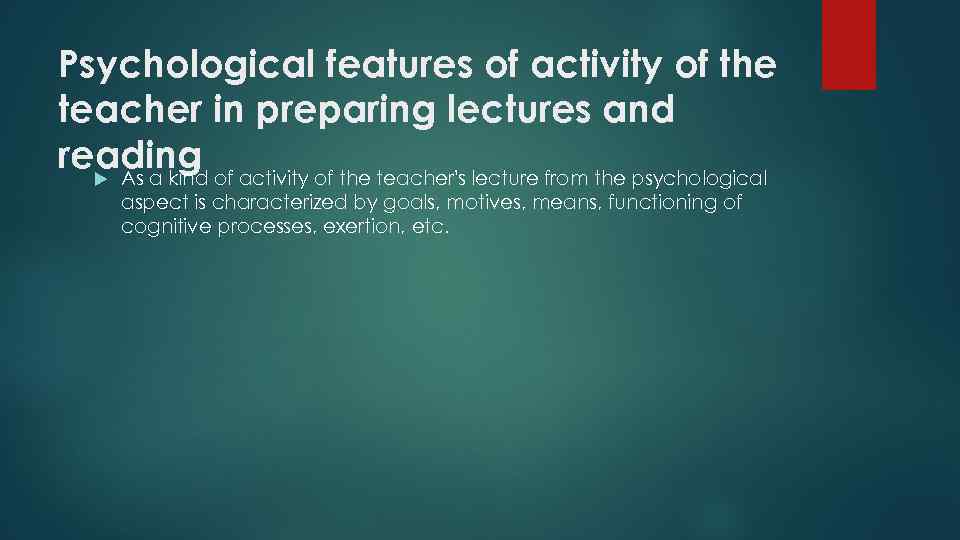
Psychological features of activity of the teacher in preparing lectures and reading of activity of the teacher's lecture from the psychological As a kind aspect is characterized by goals, motives, means, functioning of cognitive processes, exertion, etc.
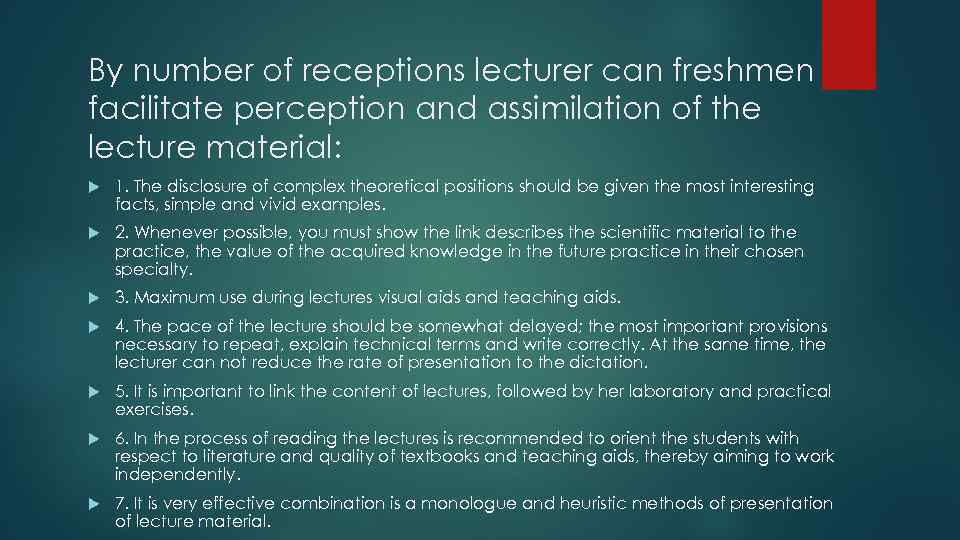
By number of receptions lecturer can freshmen facilitate perception and assimilation of the lecture material: 1. The disclosure of complex theoretical positions should be given the most interesting facts, simple and vivid examples. 2. Whenever possible, you must show the link describes the scientific material to the practice, the value of the acquired knowledge in the future practice in their chosen specialty. 3. Maximum use during lectures visual aids and teaching aids. 4. The pace of the lecture should be somewhat delayed; the most important provisions necessary to repeat, explain technical terms and write correctly. At the same time, the lecturer can not reduce the rate of presentation to the dictation. 5. It is important to link the content of lectures, followed by her laboratory and practical exercises. 6. In the process of reading the lectures is recommended to orient the students with respect to literature and quality of textbooks and teaching aids, thereby aiming to work independently. 7. It is very effective combination is a monologue and heuristic methods of presentation of lecture material.
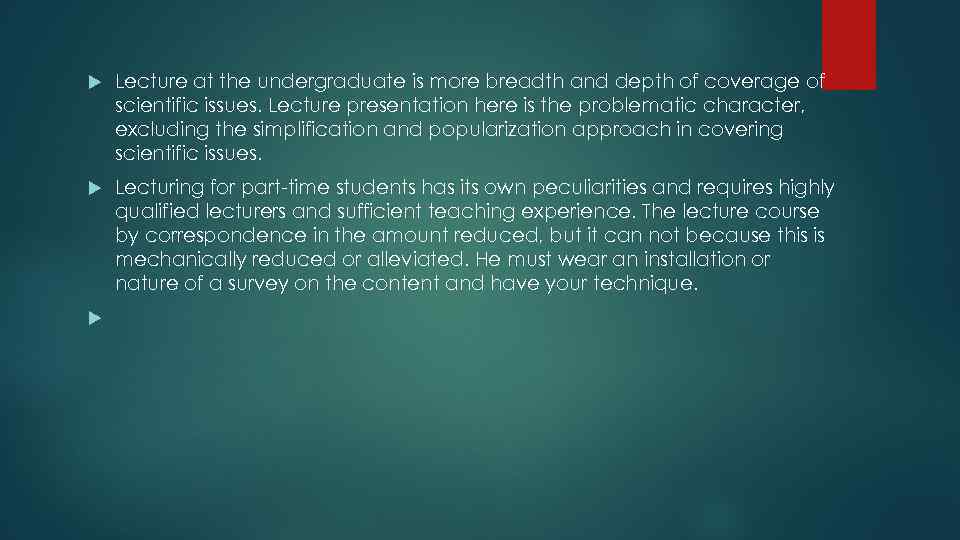
Lecture at the undergraduate is more breadth and depth of coverage of scientific issues. Lecture presentation here is the problematic character, excluding the simplification and popularization approach in covering scientific issues. Lecturing for part-time students has its own peculiarities and requires highly qualified lecturers and sufficient teaching experience. The lecture course by correspondence in the amount reduced, but it can not because this is mechanically reduced or alleviated. He must wear an installation or nature of a survey on the content and have your technique.
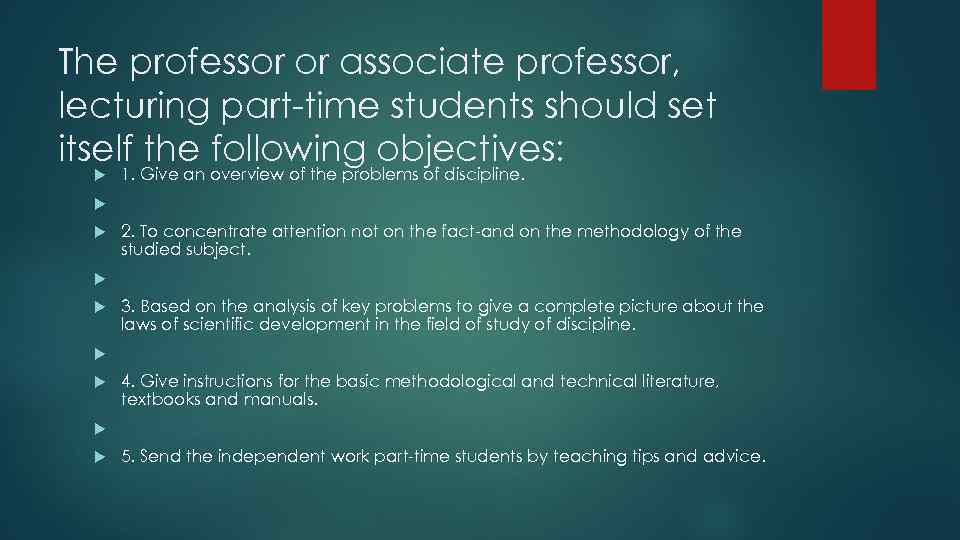
The professor or associate professor, lecturing part-time students should set itself the following objectives: 1. Give an overview of the problems of discipline. 2. To concentrate attention not on the fact-and on the methodology of the studied subject. 3. Based on the analysis of key problems to give a complete picture about the laws of scientific development in the field of study of discipline. 4. Give instructions for the basic methodological and technical literature, textbooks and manuals. 5. Send the independent work part-time students by teaching tips and advice.
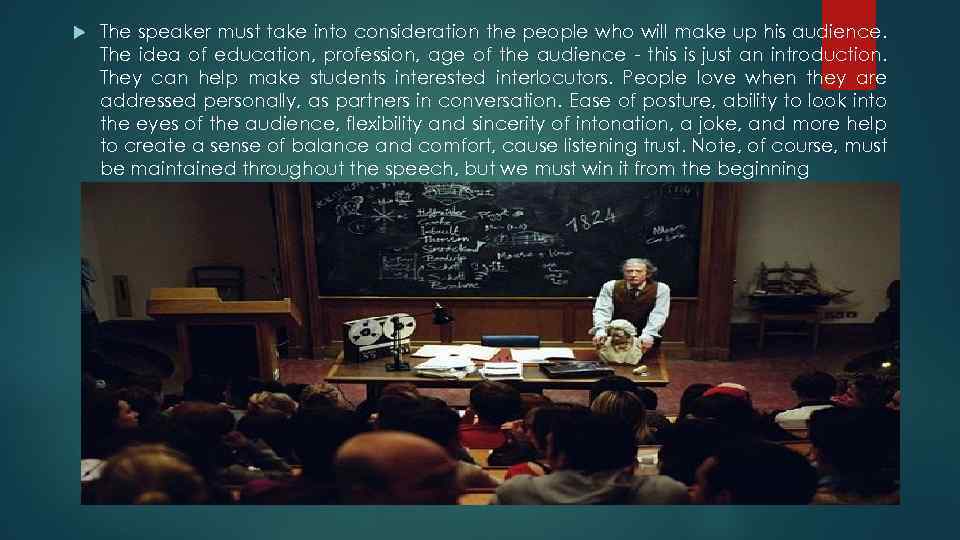
The speaker must take into consideration the people who will make up his audience. The idea of education, profession, age of the audience - this is just an introduction. They can help make students interested interlocutors. People love when they are addressed personally, as partners in conversation. Ease of posture, ability to look into the eyes of the audience, flexibility and sincerity of intonation, a joke, and more help to create a sense of balance and comfort, cause listening trust. Note, of course, must be maintained throughout the speech, but we must win it from the beginning
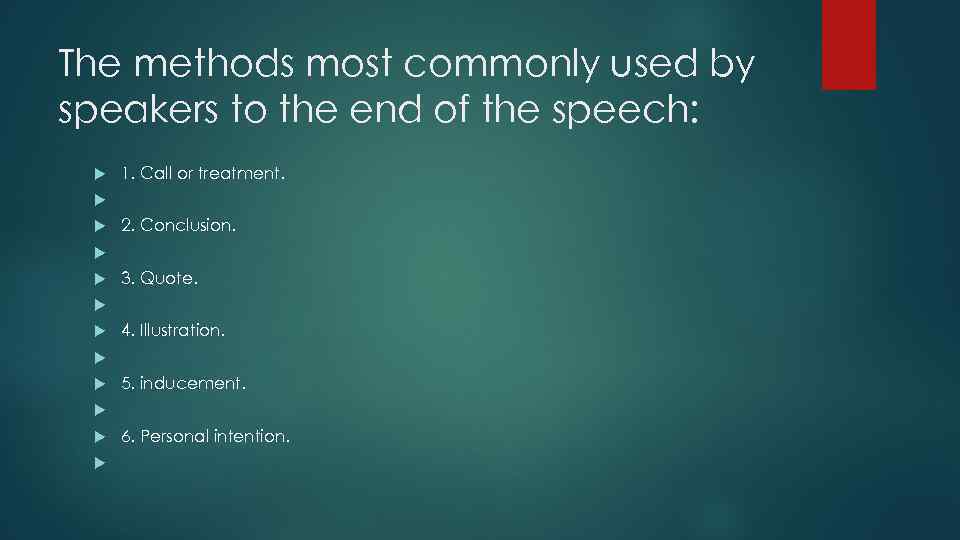
The methods most commonly used by speakers to the end of the speech: 1. Call or treatment. 2. Conclusion. 3. Quote. 4. Illustration. 5. inducement. 6. Personal intention.
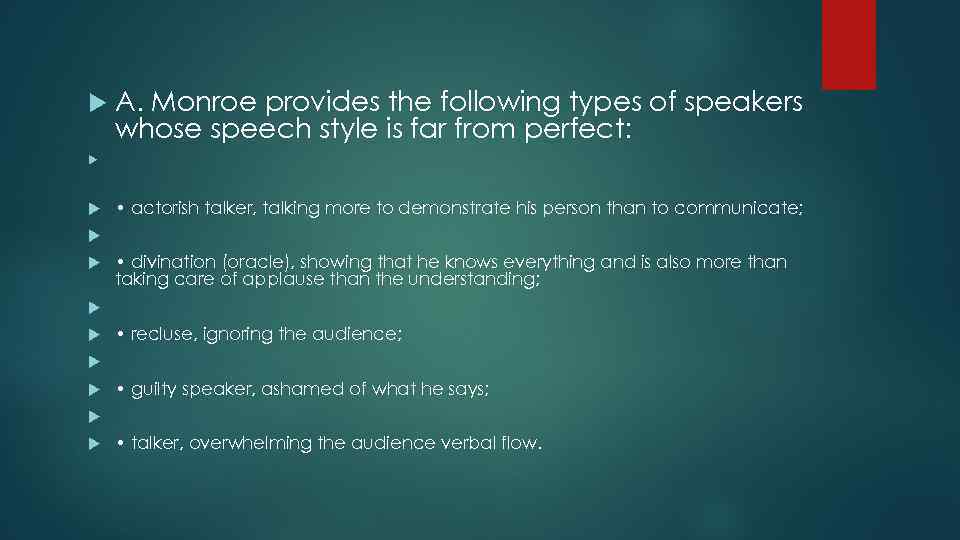
A. Monroe provides the following types of speakers whose speech style is far from perfect: • actorish talker, talking more to demonstrate his person than to communicate; • divination (oracle), showing that he knows everything and is also more than taking care of applause than the understanding; • recluse, ignoring the audience; • guilty speaker, ashamed of what he says; • talker, overwhelming the audience verbal flow.
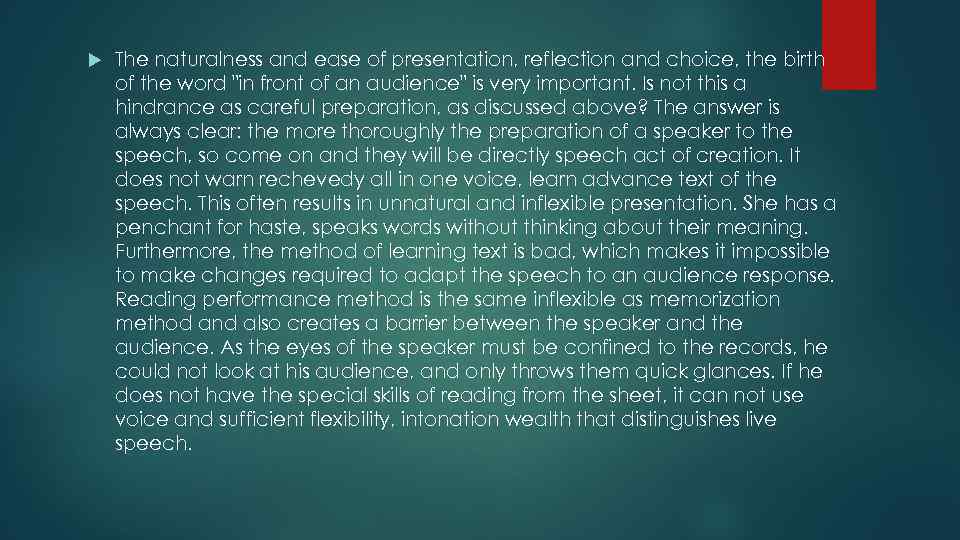
The naturalness and ease of presentation, reflection and choice, the birth of the word "in front of an audience" is very important. Is not this a hindrance as careful preparation, as discussed above? The answer is always clear: the more thoroughly the preparation of a speaker to the speech, so come on and they will be directly speech act of creation. It does not warn rechevedy all in one voice, learn advance text of the speech. This often results in unnatural and inflexible presentation. She has a penchant for haste, speaks words without thinking about their meaning. Furthermore, the method of learning text is bad, which makes it impossible to make changes required to adapt the speech to an audience response. Reading performance method is the same inflexible as memorization method and also creates a barrier between the speaker and the audience. As the eyes of the speaker must be confined to the records, he could not look at his audience, and only throws them quick glances. If he does not have the special skills of reading from the sheet, it can not use voice and sufficient flexibility, intonation wealth that distinguishes live speech.

Most good speakers use improvisation method. It must be emphasized that in this case we are very carefully planned, but the words never memorized by heart. Instead speaker postpones plan, synopsis and practiced in the loud utterance of speech, changing the words each time. Thus, it will kill two birds at once: his speech is the same calibrated and polished as memorized, and, of course, more expressive, cheerful, flexible and spontaneous. Psychological analysis of the lecture includes: 1. Analysis of lessons as a form of activity of the teacher (content and structure of this activity, the functioning of the cognitive, emotional and other mental processes, methods used, and adjusting the management practices of students, etc. ). 2. Analysis of the lectures as a form of educational activity of students (its aims, motives, methods, manifested by mental processes mental states, their dynamics, etc. ) 3. Analysis of employment as a joint activity of teacher and students (the consistency of the activity, the mental state of the teacher and students, contact and mutual understanding, and mutual relationships, etc. ).
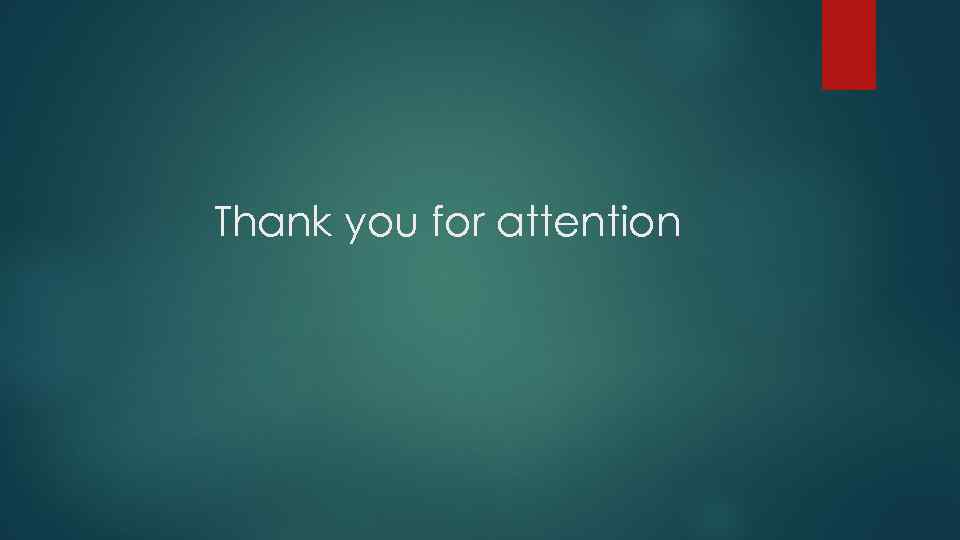
Thank you for attention
проект психология.pptx